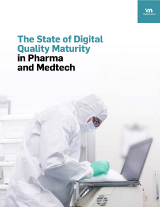
GxP Lifeline
How Digital Transformation Is Impacting Medical Device Quality and Continuous Improvement

The medical device industry has undergone a significant transformation in recent years due to the rise of digital technologies. This transformation is having a profound impact on medical device quality management and continuous improvement practices in the industry.
With the advent of artificial intelligence (AI) and electronic quality management systems (eQMS), medical device manufacturers are now able to optimize their operations to ensure that all products meet the highest standards. In this blog post, we will explore the ways in which digital transformation is impacting medical device quality and continuous improvement.
Introducing Digital Transformation
Digital transformation is fundamentally changing the medical device industry, from product design and development to manufacturing and quality control.
One of the key benefits of digital transformation is the ability to collect and analyze data from medical devices in real time. By leveraging the Internet of Things (IoT) and connectivity, manufacturers can collect data on device performance, usage, and maintenance needs, enabling them to identify issues quickly and take corrective actions.
The rise of digital transformation has also enabled medical device manufacturers to move away from traditional, paper-based systems and adopt digital quality management systems. This has improved efficiency, reduced costs, and enhanced overall performance.
By adopting digital quality management systems, manufacturers can streamline their quality and continuous improvement processes, improving transparency and ensuring that all products conform to the highest standards.
The Role of AI in Medical Device Quality Management and Continuous Improvement
AI is playing an increasingly important role in medical device quality and continuous improvement.
The key benefit of AI is its ability to analyze large amounts of data quickly and accurately. By using AI algorithms to analyze data from medical devices, manufacturers can predict when a device is likely to fail and take preventative measures.
For example, AI is being used to predict when medical imaging equipment is likely to fail. By analyzing data from the equipment in real time, the AI algorithms can predict potential failures before they occur, enabling maintenance teams to take corrective actions before the equipment breaks down. This can reduce maintenance costs and downtime, improving overall equipment effectiveness (OEE) and enhancing patient care.
AI is also being used to improve product quality. By analyzing data from product testing and inspections, AI algorithms can detect defects and quality issues with a high degree of accuracy. This helps manufacturers identify and address issues quickly, reducing the risk of recalls and improving customer satisfaction.
For example, AI is being used to detect quality issues in medical devices. By analyzing data from product testing and inspections, the algorithms can detect defects with up to 90% accuracy, compared to 70% accuracy for human inspectors. This reduces the risk of recalls, improves patient safety, and enhances product quality.
Another area where AI is being used in medical device quality management and continuous improvement is in manufacturing optimization. By analyzing data from production lines, algorithms can identify inefficiencies and suggest process improvements that can lead to increased productivity and reduced costs.
For example, AI is being used to optimize its manufacturing processes. By analyzing data from production lines, AI algorithms can identify inefficiencies and suggest process improvements, such as changes to the production schedule or adjustments to equipment settings. This can lead to increased productivity, reduced costs, and improved overall equipment effectiveness (OEE).
The Role of Continuous Improvement in Digital Transformation
Continuous improvement is a critical component of digital transformation in the medical device industry. By adopting digital quality management systems such as a medical device eQMS, manufacturers are automating many quality management processes, reducing the risk of errors and ensuring that all quality management activities are performed consistently.
One of the key benefits of a digital quality management system is its ability to improve document control. By automating document control processes, an eQMS reduces the risk of errors and ensures that all quality management activities are performed consistently. This reduces document review and approval times while improving efficiency and reducing costs.
An example application for digital quality management and continuous improvement software is in change management. By automating change management processes electronically, a manufacturer using a medical device eQMS can ensure that all changes are documented and tracked while using the processing and analytical tools to reduce the risk of errors and ensuring that all medical device quality management activities are performed consistently. This can reduce the time it takes to implement changes, improving efficiency while reducing operational costs.
For example, a leading medical technology company implemented a medical device eQMS system to automate its change management processes. By doing so, the company was able to reduce the time it takes to implement changes by 60%, resulting in significant cost savings and improved efficiency.
Moreover, medical device eQMS systems can also provide real-time insights into quality performance and continuous improvement initiatives, enabling manufacturers to quickly identify trends and areas for improvement. By using these insights to drive continuous improvement, manufacturers can continually enhance the quality of their products and processes.
One example of the use of medical device eQMS for continuous improvement is the implementation of Statistical process control (SPC) tools. SPC tools enable manufacturers to monitor their production processes in real time, identifying any variations or anomalies that could indicate quality issues. By integrating SPC tools and algorithms, manufacturers can detect quality issues quickly, reducing the risk of defects and improving overall product quality.
Conclusion
Digital transformation, AI, and medical device eQMS are revolutionizing the medical device industry and transforming the way devices are designed, manufactured, and maintained.
By collecting and analyzing data from medical devices in real time, manufacturers can predict potential issues and take corrective action, reducing costs and improving overall performance.
AI is also being used to improve product quality and manufacturing optimization, while medical device eQMS software solutions are automating medical device quality management processes and providing real-time insights for continuous improvement.
Adopting digital transformation, AI, and eQMS enables medical device manufacturers to improve their products, reduce costs, and meet the evolving needs of health care. This is critical for staying competitive and advancing healthcare quality.
Free Resource

Enjoying this blog? Learn More.
The State of Digital Quality Maturity in Pharma and Medtech
Download Now